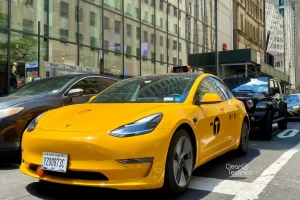Reducing transport emissions requires cities to electrify the vehicles on their roads. Yes, this means that more personal transportation will be comprised of EVs. But so, too, will bus fleets, municipal vehicles, and business vehicles need to be electrified. A comprehensive EV charging infrastructure is critical for the growth of the whole EV market, and a new report argues that cities must build EV infrastructure at scale and encourage investment from other stakeholders for full EV adoption success.
The C40 Cities Climate Leadership Group has disseminated a Knowledge Hub document, “How to Build an Electric Vehicle City: Deploying Charging Infrastructure.” The recommendations in summary are as follows.
- Cities should start by electrifying buses and municipal fleets and building the charging infrastructure needed for these fleets. In parallel, the roll out charging for the public can occur.
- Create a plan for numbers and types of chargers needed — cities should assess local factors including electric vehicle numbers, access to home charging, and future targets.
- Commit government funding, but also seek – or mandate – investment from developers, energy companies, and local businesses. Deploying at scale can drive down charging infrastructure costs.
- Collaborate with landowners, electricity companies, and others to gain permissions, build support, and get the technical details right.
This document guides cities to establish a viable EV infrastructure based on:
- the numbers and types of charger required
- the established funding models and policies to secure investment from others
- the stakeholders who need to be engaged to guide your city’s EV deployment
Look at the Comps to Figure Out How Many Charging Points are Needed
Much recent emphasis has been on creating charging points for personal EVs, and this is a valuable step toward EV adoption. However, to assess charge point numbers, cities should use benchmarks set by comparable cities and assess drivers’ access to private charging. It will be important to plan the number of chargers based on a ratio per EV, rather than a fixed number. The key factors affecting the ratio for a city are EV drivers’ access to home charging and the role of public charging in the EV uptake strategy.
If more drivers are able to charge their vehicle at their home or workplace, fewer public chargers (a higher ratio of EVs per charge point) will be required. If private parking is rare, a city will need more public chargers (a lower ratio).
Public chargers increase the confidence of drivers to move to EVs and place pressure on other stakeholders to build charging stations. When considering placement, cities should maximize usage and avoid traffic issues. Additionally, consideration should be given to minimizing stress on the power grid by placing EV chargers in areas with sufficient transformer and distribution capacity for the charger type being installed.
The endeavor doesn’t end with charger installations. Cities should ensure that charging infrastructure keeps up with demand by monitoring the numbers of EVs, EV charge points, and demand for charge points.
Determining the Mix of Charge Types Necessary to Meet Local Needs
Because of the various types of chargers available and the differing charging needs of plug-in battery electric vehicles (BEVs) and plug-in hybrid electric vehicles (PHEVs), it makes sense for cities to start planning for charging points by focusing on the vehicles over which they have the most control: electrifying buses, municipal fleets –public works, police, and other city-owned vehicles — and taxis.
With electrifying city vehicles comes building the charging infrastructure they need. Buses can use slow or fast overnight charging, or fast on-route charging. An appropriate balance should be struck between rapid and slower charging points informed by where, when, and what types of vehicles EV drivers will be charging.
To establish this balance, cities can undertake a market analysis of:
- The types of EV that residents are driving or projected to be driving according to city EV targets. Higher percentages of PHEVs relative to BEVs will require more slower chargers, and vice versa.
- Where and when they are charging. Higher percentages of EV drivers charging on route, rather than overnight or at their workplaces, will require more fast chargers and vice versa.
These ratios vary greatly between leading city markets. Chinese cities typically have a high proportion of rapid chargers, for example, while cities in Europe and North America have a much lower amount.
Commit Government Funding
The major costs to government-led programs include upgrading the electricity grid to support rapid chargers, the purchase and installation of the charge points, and land procurement, administration, and maintenance. Cities can help to encourage innovation and drive down prices by setting ambitious targets for deployment at scale.
To minimize the costs of constructing a charging network, cities can:
- use stations with multiple rather than singular connectors, and (cheaper) wall-mounted rather than freestanding charging stations
- construct multiple stations in the same area, depending on demand, to reduce installation and electrical infrastructure costs
- prioritize charge points in, or nearby, areas with sufficient electrical capacity
- install slower chargers, or low-power fast chargers of 50kW, wherever possible – particularly for on-street residential and workplace charging – as these are cheaper and are less likely to require upgrades to the electricity grid
Update Local Policies & Incentives to Build Charging EV Infrastructure
Cities can transition to commercially sustainable models and secure investment from other stakeholders to reduce government costs. Proven alternative models for financing EV charging infrastructure are:
- EV-ready building codes. Cities can require EV charging infrastructure in new developments and in redeveloped residential, commercial. and municipal parking.
- Encourage investment from EV manufacturers. Cities can encourage investment from EV automakers by committing to phasing out petrol and diesel vehicles in major urban zones, mandating EV charging at petrol stations, and incentivizing EV uptake.
- Secure investment from local businesses. Some retailers are willing to install and host charging stations because they can earn revenue while EV drivers charge their cars.
- Incentivize landowners to make land available for charging. Cities can provide tax incentives and other revenues to landowners who enable EV charging on their sites.
- Streamline the permitting process. Many cities have expedited lengthy and bureaucratic permitting processes, which can discourage investment in charging infrastructure.
Collaborate to Build Support, Secure Investment, & Get the Technical Details Right
EV charging infrastructure roll-out is typically led by the city’s transport department, working closely with energy and planning sector colleagues. Decisions about who to engage in developing EV charging plans should be guided by how the road, land, and electrical systems work in a city.
- Coordinate with energy companies. Cities must work with energy providers and network operators to design the charging infrastructure, so as to minimize installation costs and stress on the power grid. If upgrades to local energy infrastructure are required, energy providers and network operators will need to align their investment plans with the city’s EV infrastructure needs.
- Build support from landowners. The mayor’s office, or equivalent municipal office, often doesn’t own or run aspects of the city fabric that need to be built upon or upgraded to build EV charging infrastructure. This means that the city typically needs the support of landowners – private landowners or other local authorities – and planning permission to build EV charging points.
- Consider establishing a coalition of stakeholders to build a long-term strategy and align investment plans. This is what London did in 2018. EV charging in London is heavily subsidized by Transport for London. The EV Infrastructure Task Force – made up of city officials, the car industry, electricity providers, fleet managers, and others – came together to establish a long-term, sustainable delivery plan.
Final Thoughts about Cities & EV Infrastructure
The authors of “How to Build an Electric Vehicle City: Deploying Charging Infrastructure” celebrate EVs as as a way for cities to reduce local air pollution, greenhouse gas emissions, and transport sector oil use. They say that, when powered by renewable energy, EVs can produce zero emissions at the vehicle tailpipe and much lower life-cycle emissions.
However, the authors remind us that EVs still contribute to congestion and air pollution due to particles released from tires and braking. Therefore, they recommend that a shift to EVs should be positioned within a wider plan for most city journeys to be made by public transport, bike, or on foot.





